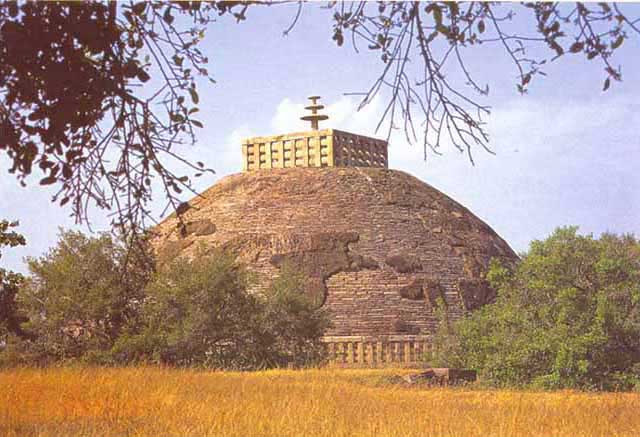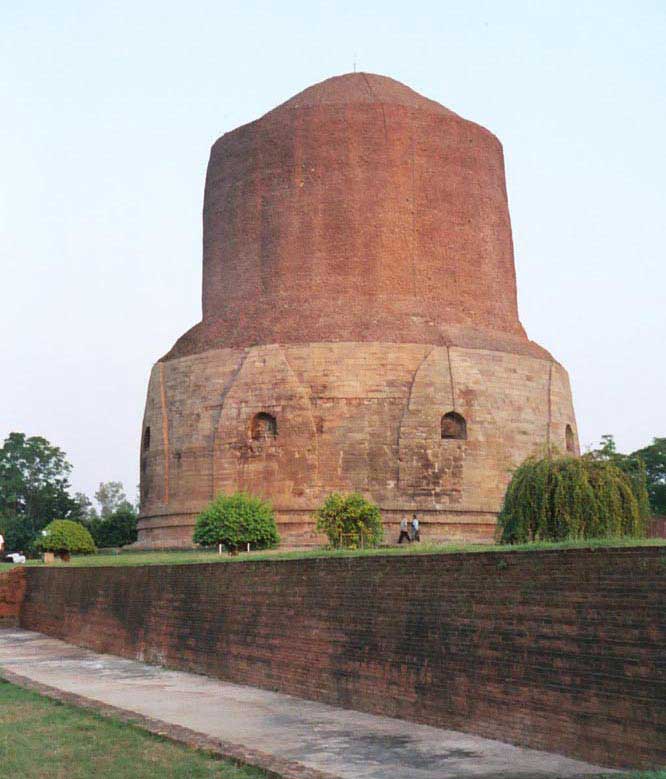......
STUPAS





STUPAS
Stupas were built of stones or bricks to commemorate important events or mark important places associated with Buddhism or to house important relics of Buddha. Ashok Maurya who laid the foundation of this group of monuments is said to have built 84,000 stupas, most of which have perished.
The best examples of stupas are those constructed at Amaravati, Sanchi, Barhut and Gaya. "One of the most striking architectural remains of ancient India" and the earliest and largest of the three stupas found in Sanchi was built by Ashoka (273-236 B.C.)

Great Stupa, Sanchi
(Picture courtesy Archaeological Survey of India)
Sanchi in Raisen district of Madhya Pradesh is famous for its magnificent Buddhist monuments and edifices. Situated on a hill, these beautiful and well-preserved stupas depict the various stages of development of Buddhist art and arch1teeture over a period of thirteen hundred years from the third century B.C. to the twelfth century A.D. Inscriptions show that these monuments were maintained by the rich merchants of that region.
The stupa built by Ashoka was damaged during the break-up of the Maurya Empire. In the 2nd century B.C., during the. rule of the Sungas it was completely reconstructed. Religious activity led to the improvement and enlargement of the stupa and a stone railing was built around it. It was also embellished with the construction of heavily carved gateways.
The Great stupa has a large hemispherical dome which is flat at the top, and crowned by a triple umbrella or Chattra on a pedestal surrounded by a square railing or Karmika. Buddha's relics were placed in a casket chamber in the centre of the Dome. At the base of the dome is a high circular terrace probably meant for parikrama or circumambulation and an encircling balustrade. At the ground level is a stone-paved procession path and another stone Balustrade and two flights of steps leading to the circular terrace. Access to it is through four exquisitely carved gateways or Toranas in the North, South, East and West. The diameter of the stupa is 36.60 metres and its height is 16.46 metres. It is built of large burnt bricks and mud mortar. It is presumed that the elaborately carved Toranas were built by ivory or metal workers in the 1st. Century BC during the reign of King Satakarni of the Satavahana Dynasty. The last addition to the stupa was made during the early 4th Century AD in the Gupta period when four images of Buddha sitting in the dhyana mudra or meditation were installed at the four entrances.

Northern Gateway, Great Stupa, Sanchi
(Picture courtesy Archaeological Survey of India)
The first Torana gateway to be built is the one at the principal entrance on the South. Each gateway has two square pillars. Crowning each pillar on. all four sides are four elephants, four lions and four dwarfs. The four dwarfs support a superstructure of three architraves or carved panels one above the other. Between these are intricately carved elephants and riders on horseback. The lowest architrave is supported on exquisitely carved bracket figures. The panels are decorated with finely carved figures of men, women, yakshas, lions and elephants. The entire panel of the gateways is covered with sculptured scenes from the life of Buddha, the Jataka Tales, events of the Buddhist times and rows of floral or lotus motifs. The scenes from Buddha's life show Buddha represented by symbols - the lotus, wheel a riderless caparisoned horse, an umbrella held above a throne, foot prints and the triratnas which are symbolic of Buddha, Dharma and Sangha. The top panel has a Dharma chakra with two Yakshas on either side holding chamaras. South of the Scenes depicted from Buddha's life are the Enlightenment of Buddha (a throne beneath a peepul tree); the First Sermon (a Dharma chakra placed on a throne); The Great Departure ( a riderless horse and an empty chariot with an umbrella above ); Sujata's offering and the temptation and assault by Mara.
The big Stupa at Bharhut also in Madhya Pradesh was constructed in the 2nd century BC in the Sunga Period. It is a hemispherical dome built of brick and is surmounted by a shaft and an umbrella to represent the spiritual sovereignty of Buddhism. The railing surrounding it is of red sandstone. Scenes from the life of Buddha and the Jataka Tales are sculptured on the gateways, pillars, uprights and cross-bars of the railings.
During the same period, a number of stupas, chaityas, viharas and pillars were constructed in Sanchi, Bodh-Gaya, Mathura, Gandhara, Amaravati and Nagarjunakonda. Though most of these have not remained in their entirety, the ruins are of architectural interest.
The Stupas of Nagajunakonda and Amaravati, both in the Guntur District of Andhra Pradesh show that the Stupas of the Southern region differ in structure from those of the North. The architecture here is a shift from the usual Buddhist style, which reflected the two main divisions in Buddhism - Hinayana and Mahayana. Different trends and styles were incorporated here giving rise to new architectural forms, i.e. a quadrangular monastery, square and rectangular image shrine, pillared hall and a. small stupa on a square platform.
The stupas of Nagarjunakonda are in the form of a hemispherical dome resting on a low drum encased in panels sculptured with scenes of events depicting the life of Buddha. A notable feature of the stupas here is ayaka platforms in the four directions with five inscribed pillars on each of them. The five pillars symbolise the five important events in the life of Buddha - his Birth, Renunciation, Enlightenment, First Sermon and Parinirvana.
Some of the stupas are built on a square platform having an apsidal shrine on either side and a pillared hall within a quadrangular monastery. Some stupas were wheel-shaped having four to ten spokes and a two or three winged vihara.
The earliest of the Nagarjunkonda stupas is the Maha Chaitya which contains the tooth relic of Buddha. The stupa is wheel-shaped with ayaka platforms surmounted by pillars. The smallest stupa here has only two cells and the Chaitya griha enshrines the image of Buddha.
Ruins of stupas have been found in Rajgriha or Rajgir (Bihar) where the First Buddhist Council was held; at Vaisali (Bihar) where the Second Buddhist Council was held and at Sravasti (U.P.) one of the eight places of Buddhist pilgrimage where Buddha is said to have performed the Great Miracle. To show his spiritual powers, he made a mango tree to sprout in a day and created numerous images of himself, sitting and standing on lotuses with fire and water emanating from his body. The conversion of King Prasenajit and the dacoit Angulimala is also said to have taken place here.
Ruins of the main stupa in Kusinagara in U.P. where Buddha passed away and was cremated, is believed to contain the bodily remains of Buddha. Both Fa-hien and Hiuen- Tsang have recorded their visits to these places.

Dharmaksha Stupa, Sarnath
(Picture courtesy Archaeological Survey of India)
The Dhamekh Stupa and the Dharmarajika stupa at Sarnath are believed to have been built by Ashoka and later rebuilt in the Gupta period. These stupas contain the relics of Buddha and are therefore important places of Buddhist pilgrimage. Buddha gave his First Sermon in Sarnath and also founded the Sangha or Order of Monks here. The original Dhamekh Stupa built with mud or brick is a cylindrical structure 43.5 m. high. The stone basement has eight projecting faces with niches in them. Delicately carved with beautiful floral and geometrical patterns, it is believed to have been put up in thc Gupta period.
No comments:
Post a Comment